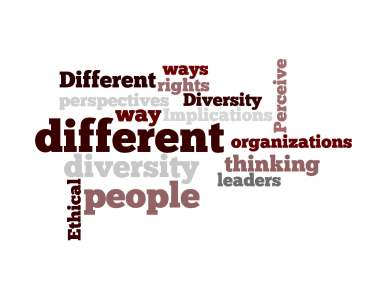
by Linda Fisher Thornton
A Diversity Focus Can Be Divisive
When we talk about diversity, we are noticing differences. That may not seem like a profound statement at first, but think about it for a moment. In a work environment, diversity is about having different types of employees, right? And that’s a good thing for productivity and innovation, isn’t it? It is a good thing. But it’s not enough.
Managing diversity without inclusion as the ultimate goal can make a big difference in the way employees experience our organization. We choose a way of thinking that represents what we’re trying to do and then build a process/program/structure or measurement based on that foundation. If diversity is our way of thinking, we may get an approach based on “differences,” rather than one based on creating an inclusive culture where a diverse group of people can do their best work.
How we Perceive “Different” Has Ethical and Organizational Implications
“There are a number of ways to perceive people who are different from us and ideas that are different from ours. Some are more positive and productive than others” (Linda Fisher Thornton, “Ethical Implications of How Leaders Perceive ‘Different'”).”
As leaders, how we choose to handle people who are “different” from us in some way shapes our organizational culture in important ways. Tamara Erickson, McKinsey award-winning author, calls for a higher level of diversity understanding in organizations:
“There is a third stage of diversity, perhaps aspirational for most today, represented by a fundamental shift in attitudes toward people who are in any way different… My wish for 2011 is that more organizations will include programs aimed to reach this stage as an important component of their diversity goals.”
Tamara J. Erickson in Level Three Diversity: Moving Beyond Political Correctness,” Diversity Executive, January/February 2011
As leaders, we need to understand our choices and the potential ethical impact of those choices on our employees and our organizations. Honoring human rights fundamentally means honoring everyone, regardless of background or perspective. Are we living that every day in our organizational leadership?
In Inclusive Organizations, Differences are Seen as Enhancing Organizational Innovation
The excerpt below is from Leading in Context® Training Module “Ethical Implications of How Leaders Perceive Different” which provides a framework for thinking and talking about how we handle “different” in our organizations.
Perceptions of “Different” Impact Our Behavior
“How we think as leaders directly impacts our leadership behavior. It compels us to act and to make decisions in the context of the value judgments we make.”
“Unfortunately, we don’t always use the word “different” to describe things and people and ideas that are new to us. We often use less friendly words that indicate that the person or idea is wrong, misguided or harmful. When we are perceiving “different” as wrong, misguided or harmful, we are more likely to treat people in ways that are not respectful. When we are open to hearing “different” perspectives we are more likely to lead in responsible, inclusive ways.”
“Because our thinking process shapes our decisions, as leaders we must be careful to use thinking processes that are inclusive and that respect the rights of other people to have their own perspectives and opinions.”
Excerpts from “Ethical Implications of How Leaders Perceive Different” by Linda Fisher Thornton
As Howard Winters said, “Civilization is the process in which one gradually increases the number of people included in the term ‘we’ or ‘us’ and at the same time decreases those labeled ‘you’ or ‘them’ until that category has no one left in it.”
“The ‘different’ perspectives and opinions of those we lead do not undermine our leadership position. In fact, it is those new ideas and perspectives that will help us keep our company adaptable, engaging and competitive in a global marketplace.” (Linda Fisher Thornton, “Ethical Implications of How Leaders Perceive ‘Different'”).
At its highest level, inclusion is about honoring human rights. Consider whether you are managing diversity or working toward full inclusion in a way that respects human rights. These resources will help you explore the differences between leading with a diversity-based approach and leading for full inclusion.
Resources for Moving From Differences to Inclusion
ILR Impact Brief: Diversity and Inclusion: Is There Really a Difference? Cornell University, ilr.cornell.edu
The Netter Principles, glaxdiversitycouncil.com
A Framework for Building Organizational Inclusion, Working Paper Number 2, Bormann and Woods, The Workplace Diversity Network, Cornell University, ilr.cornell.edu
What is Inclusion? Inclusion Network, Inclusion.com

For more, see Linda’s book 7 Lenses and the 21 Question Assessment: How Current is My Message About Ethics?
 2014 Axiom Business Book Award Winner
About 7 Lenses
Info@LeadinginContext.com @leadingincontxt @7Lenses
2014 Axiom Business Book Award Winner
About 7 Lenses
Info@LeadinginContext.com @leadingincontxt @7Lenses
© 2012 Leading in Context LLC
Thanks for your observations David. This post was designed to stimulate the kinds of questions you are raising about inclusion in a global society. The way that we choose to deal with inclusion in our organizations has ethical implications. We need to examine the thinking behind our approach to be sure that we are honoring human rights (which incorporates all cultures).
LikeLike
I’m a bit perplexed as to the topic here. Is it inclusion or ethics? A leader has no liberty to use different ethical standards because of differences in ethnicity. It the leader does this, he/she must be confronted and re-trained on ethical practices.
My prospectives comes from over 50 years of leadership in several organizations with a huge mix of ethnicity for several different countries around the world. I have found that, as a leader, if I treat every employee with the same ethical standard, never my own take on the ethical standard, but the company standard according to the law, then I am respected for my leadership and employees trust me and my leadership.
Furthermore, in today’s work environment, inclusion is equally required. Again, leaders have no liberty in deciding who to include and who can be excluded, if the decision is based on ethnicity. The individual person’s capability is another and different factor. Ethically, leaders need to remove personal bias and prejudices or be removed from leadership positions until they make a personal change.
As Peter Drucker pointed out years ago, there is only ethical standard, that being to knowingly do no harm. Treat others the way you want to be treated is the ethical standard.
LikeLike
From my prospective as a leader with extensive experience in many organizations with people of several ethnic backgrounds, a leader is obligated to treat every employee — follower, peer, superior — with the same ethical standard. There “should” be no “thinking” about it, especially as it pertains to the ethnic background of the led. Furthermore, if a leader percieves ethical difference in individuals, regardless of their ethnicity, that issue and concern needs to be confronted and addressed with training as to the company standard.
Leaders today don’t have the liberty to consider differences as it pertains to ethics. We do need to understand the ethnic differences in people. However, all individuals are obligated to conform to company ethical standards, with no tolerance for individual beliefs that run counter to those standards.
Treating people with respect, treating people equally, is leadership in motion. I have found that people who are respected for their contribution to the organization will perform to their capabilities and conform to ethical policies of the organization.
LikeLike